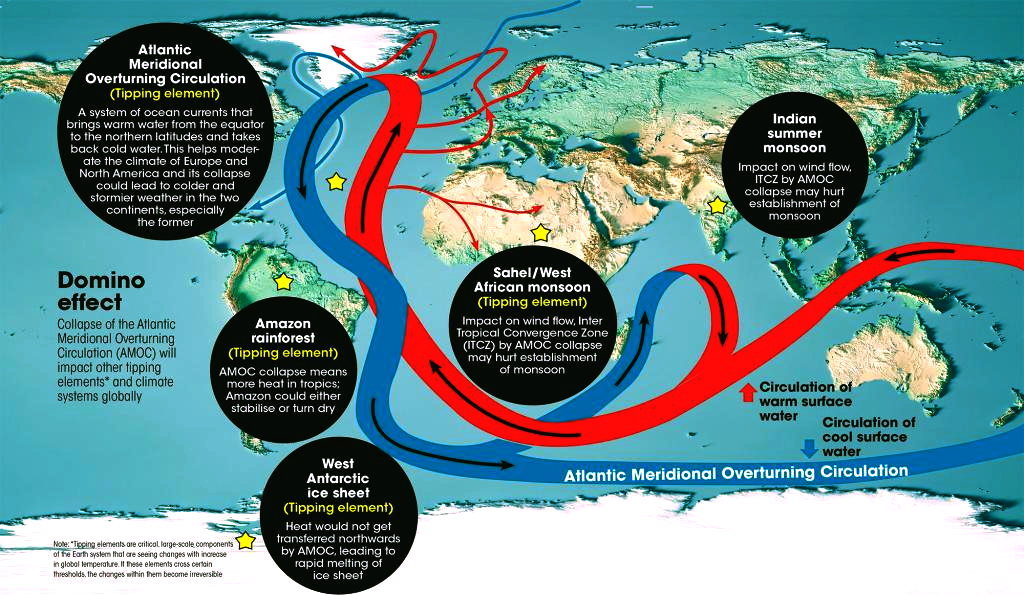Important Facts For Prelims
Atlantic Meridional Overturning Circulation
- 14 Feb 2024
- 4 min read
Why in News?
The Atlantic Meridional Overturning Circulation (AMOC) is at risk of imminent collapse, with recent studies indicating that anthropogenic emissions could expedite this between 2025 and 2095.
What is AMOC?
- About:
- AMOC is a large-scale oceanic circulation system that transports warm surface waters from the tropics to the northern latitudes and returns cold, deep waters from the North Atlantic back towards the equator.
- It plays a crucial role in redistributing heat globally, influencing regional and global climates, especially moderating temperatures in Europe, North America, and near the Equator.
- AMOC is a large-scale oceanic circulation system that transports warm surface waters from the tropics to the northern latitudes and returns cold, deep waters from the North Atlantic back towards the equator.
- Mechanism:
- Warm Water Transport: AMOC transports warm, salty surface waters from the tropics to the northern regions. These warm waters carry heat energy, contributing to the warming of regions like Europe.
- Cooling and Density Increase: As the warm surface waters move towards the poles, they gradually cool due to heat loss to the atmosphere. Also, cold, fresh water from the melting ice of the Arctic is added to the cooler ocean.
- Downwelling: Once cooled, the dense, cold water sinks to deeper layers of the ocean in a process known as downwelling.
- This downwelling occurs primarily in the North Atlantic Ocean, where the dense water mass forms and begins its southward journey.
- Southward Flow: The cold, dense water flows southward along the ocean floor, traversing vast distances across the Atlantic basin.
- This southward flow represents the deep limb of the AMOC, where cold, dense water mass redistributes heat and nutrients throughout the ocean.
- As the water resurfaces, it begins to warm up again, completing the circulation cycle of the AMOC.
- Role of Indian Ocean: As the Indian Ocean warms faster and faster, it generates additional precipitation. This draws more air from other parts of the world to the Indian Ocean, including the Atlantic. With so much precipitation in the Indian Ocean, there will be less precipitation in the Atlantic Ocean.
- Less precipitation will lead to higher salinity in the waters of the tropical portion of the Atlantic — because there won’t be as much rainwater to dilute it.
- This saltier water in the Atlantic, as it comes north via AMOC, will get cold much quicker than usual and sink faster.
- This would act as a jump start for AMOC, intensifying the circulation.
- Contribution to Global Climate: This cycle acts like a heat conveyor belt, warming the northern latitudes and cooling the southern latitudes, contributing to the overall stability of the Earth's climate.
- Threat: Rising precipitation and accelerated melting of the Greenland ice sheet have introduced more cold freshwater into the North Atlantic.
- This influx has lowered water salinity and density, causing the colder ocean layer to expand while the warmer layer contracts.
- Consequently, the AMOC is slowing down, posing a risk of collapse.
- Also, anthropogenic activities, such as greenhouse gas emissions, can influence ocean temperatures and circulation patterns, further affecting the AMOC.
- Potential Cascading Effects:
- AMOC collapse may alter precipitation patterns, potentially destabilizing the southern Amazon rainforest and transforming it into a savannah-like ecosystem.
- Increased ocean heat in the southern hemisphere could accelerate the melting of the West Antarctic ice sheet, exacerbating sea-level rise.
- Weakening of monsoon circulation in regions like South Asia and Africa could have far-reaching consequences for agriculture, water resources, and regional climates.






-min.jpg)